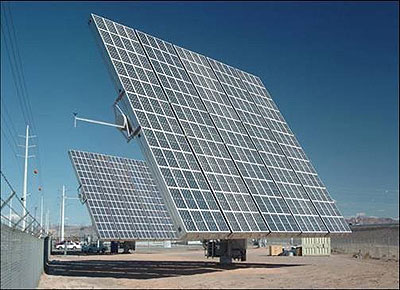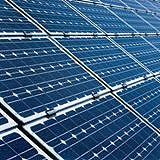A market growing at 45 percent per year looks like a good bet to get into. According to Mike Taylor, director of research and education, Solar Electric Power Association, the solar photovoltaic for electric generation market has been on that slope for the past three years. No wonder automation companies are developing solutions for the solar panel market.

Taylor says that Europe has been the photovoltaic leader, but that the U.S. market is rapidly developing. Putting to rest the myth that solar implementations require never-ending sun, the current market leader is Germany—not exactly a sunny country. Spain follows, with the United States third in market size.
“In the United States, we just broke the 300 megawatt (MW) barrier in photovoltaic electric generation in 2008. By comparison, in 2007 the total was 160 MW and in 2006 it was not quite 100 MW,” says Taylor. “With the entry of utilities and big box commercial stores into the (solar energy use) market, it’s just going to keep growing.”
Siemens has been involved in the solar industry for many years and has honed its automation offering to fit the needs of solar panel manufacturers. Apparently simple from the outside, these panels are multiple layers of materials that must be precisely sized, cut, stacked and sealed. If dirt, dust or contaminants land on any of these layers before the unit is laminated, it more than likely will affect the performance of the solar panel. The assembly process must assure the final product is impervious to weather and other outdoor environmental hazards.
Complex manufacturing
The manufacturing process includes accurately measuring, cutting, transporting, positioning and stacking insulation, protective film and other layers of proprietary films onto expensive and fragile sheets of photovoltaic silicone without contaminating any of the layers. If the silicone layer is dropped, bumped or hit with too much force, the sheets can crack or break into shards. The films come from rolls and are cut to length and registered to position onto the substrate. The end result is a hermetically sealed panel that converts solar energy into electricity for residential or commercial use.
A company located near Chicago specializes in building machinery to manufacture these panels. A Siemens 317T programmable logic controller
“This was a new project for this customer,” says Ken Brey, technical director for DMC Inc., an automation engineering and software services company located in Chicago. “This customer requested Siemens equipment to match the rest of their automation equipment. They know that Siemens equipment would not only give them continuity in the hardware and software, but would also give them the high level of performance and operation they expected. They also know from experience that Siemens service is much easier to get globally than other brands.”
(PLC) controls the process. This PLC employs CPU 317T-2 DP technology which adds powerful motion control functions to the existing range of standard central processing units (CPUs). These motion control functions are integrated in the CPU firmware and are supported by a co-processor for high-speed closed-loop control. This ensures that the performance of the CPU 317 for normal control tasks is maintained and that the motion control functions can be computed at a higher clock rate.
Like making a sandwich

As Brey explains it, the process of making these panels is similar to making a sandwich. Instead of bread, glass panels make up the first layer. Instead of meat or cheese, EVA and insulation material make up the second layer. The solar panels get placed into the sandwich and are put into a laminator to seal everything together.
“Our customer’s machines cut and place the middle layers onto a vacuum conveyor. The machine positions the panel under the leading edge of the EVA and feeds the panel and the EVA together to build our “sandwich.” The laminating process is done with another company’s equipment,” states Brey. “The end customer was building an entire factory from scratch with equipment from different vendors. Standardizing on Siemens was the quickest and easiest way for the equipment to communicate as well as ensuring the job met the customer’s high expectations,” according to Brey.
A typical motion control application like this assembly process needs to control 2 to 8 axes. The Siemens 317T PLC can control up to 16 axes. In addition to accurate single axis positioning, the technology CPU is particularly suited for complex, synchronized motion sequences, such as coupling with a virtual or real master, geared synchronous motion, electronic cam discs and print mark correction. Print mark registration is particularly important in the solar panel lamination process so film is properly aligned onto the photovoltaic cells. Using Siemens STEP 7 software, only one program is needed for PLC and motion control, making configuration and programming significantly easier and faster.
The processor in the solar panel assembly machine has motion control functions integrated into the CPU that guide four servo axes to position the film. It allows the process to run at high speeds without a separate motion controller. Accurate registration of the film is achieved using the built-in geared synchronous motion and measuring probe functions of the 317T PLC. Siemens solution provider, DMC, Inc., installed the control system at the manufacturer’s facility near Chicago and the machine now resides in the photovoltaic panel plant in Europe.
SEPA’s Taylor has calculated from public announcements of utilities that 2,500 MW of electric generation from photovoltaic panels is projected for manufacture in the next five years. With utilities and large commercial enterprises such as Wal-Mart looking at adding solar generating equipment, the demand for these Siemens controlled assembly machines should be sky high.
For more information on Siemens Solar Industry Solutions, please click here.








1 Comments:
Solar power is a renewable source of energy and never runs out. Also solar power is environmentally friendly and doesn't cost any money once its setup.
solar energy
solar power
solar hot water
solar panels
Post a Comment